The String of Hearts plant is a visually stunning houseplant that will add a touch of charm to any space. With its delicate vines and heart-shaped leaves, it is a true delight to behold. The foliage of the String of Hearts is not only heart-shaped but also adorned with intricate patterns, giving it a unique and mesmerizing appearance.
Appearance of the String of Hearts Plant


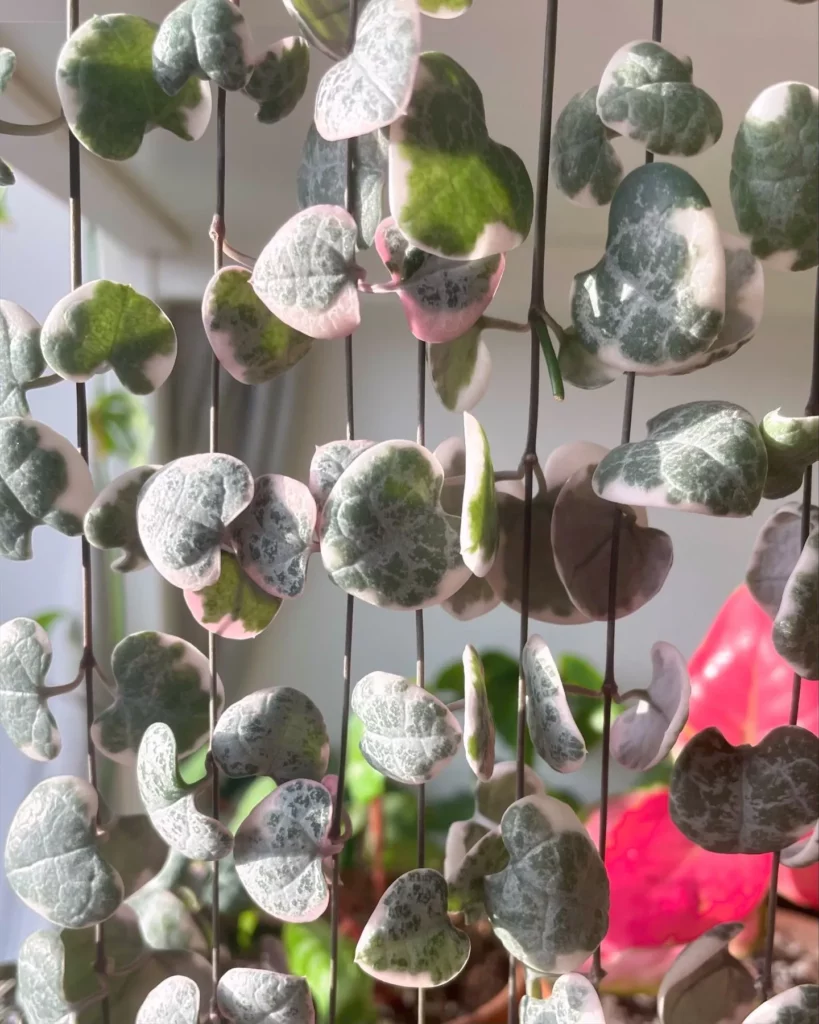
This plant comes in various forms, including variegated types like the String of Spades and String of Needles, which add even more visual interest to its foliage. The variegated varieties display beautiful contrasting colors, making them truly eye-catching.
When grown as a hanging plant, the String of Hearts can create a stunning curtain of hearts, with its vines reaching lengths of 2-3 meters. This trailing display is sure to be a conversation starter and a focal point in any room.
Aside from its foliage, the String of Hearts also produces unique vessel-shaped flowers in the spring and summer. While not as prominent as the foliage, these flowers add an extra touch of beauty and intrigue to the plant.
Light Requirements for the String of Hearts Plant

Providing the right amount of light is crucial for the healthy growth of your String of Hearts plant. This charming indoor plant thrives in bright indirect light, making it an ideal addition to your home or office space.
The String of Hearts plant should be placed in a location that receives ample light, but it should be protected from direct sunlight, especially during the hottest part of the day. Too much direct sunlight can scorch the delicate leaves of the plant.
An ideal spot for your String of Hearts plant is on a shelf near a window or in a hanging pot, allowing its long vines and heart-shaped leaves to trail gracefully over the edges. This not only creates a visually appealing display but also ensures that the plant receives enough light to support its growth.
Remember that finding the right balance of light is essential. If your String of Hearts plant receives too little light, it may become leggy and lose its vibrant colors. On the other hand, if it receives too much direct sunlight, the foliage may become damaged and turn brown.
| Light Requirement | Details |
|---|---|
| Bright Indirect Light | Place the String of Hearts plant in a spot that receives ample light without direct sun exposure. |
| Protected from Direct Sunlight | Prevent the String of Hearts plant from being exposed to direct sunlight, especially during the heat of the day. |
| Ideal for Shelf or Hanging Pot | Growing the plant on a shelf or in a hanging pot allows its vines to trail gracefully and ensures adequate light exposure. |
Watering the String of Hearts Plant
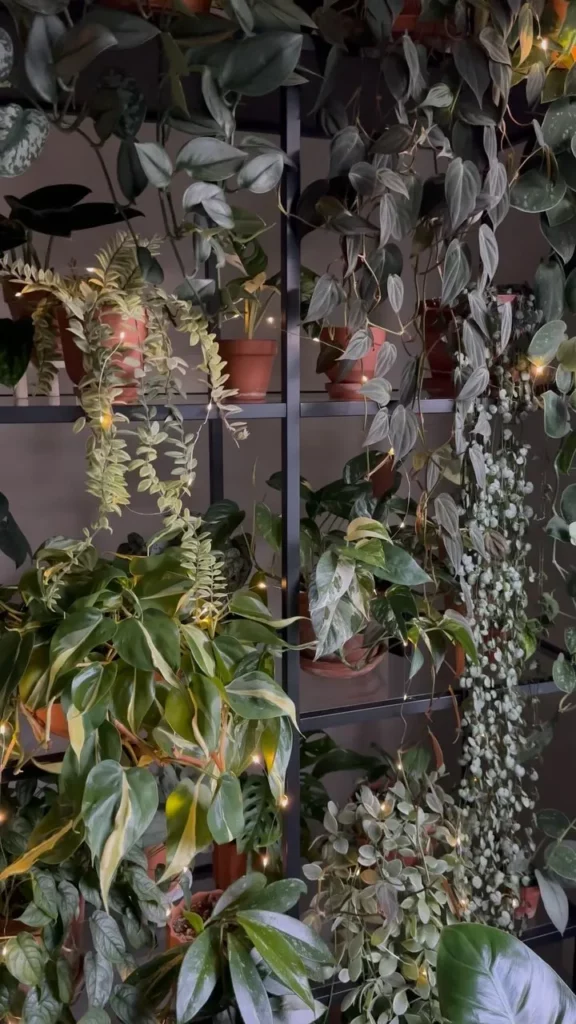

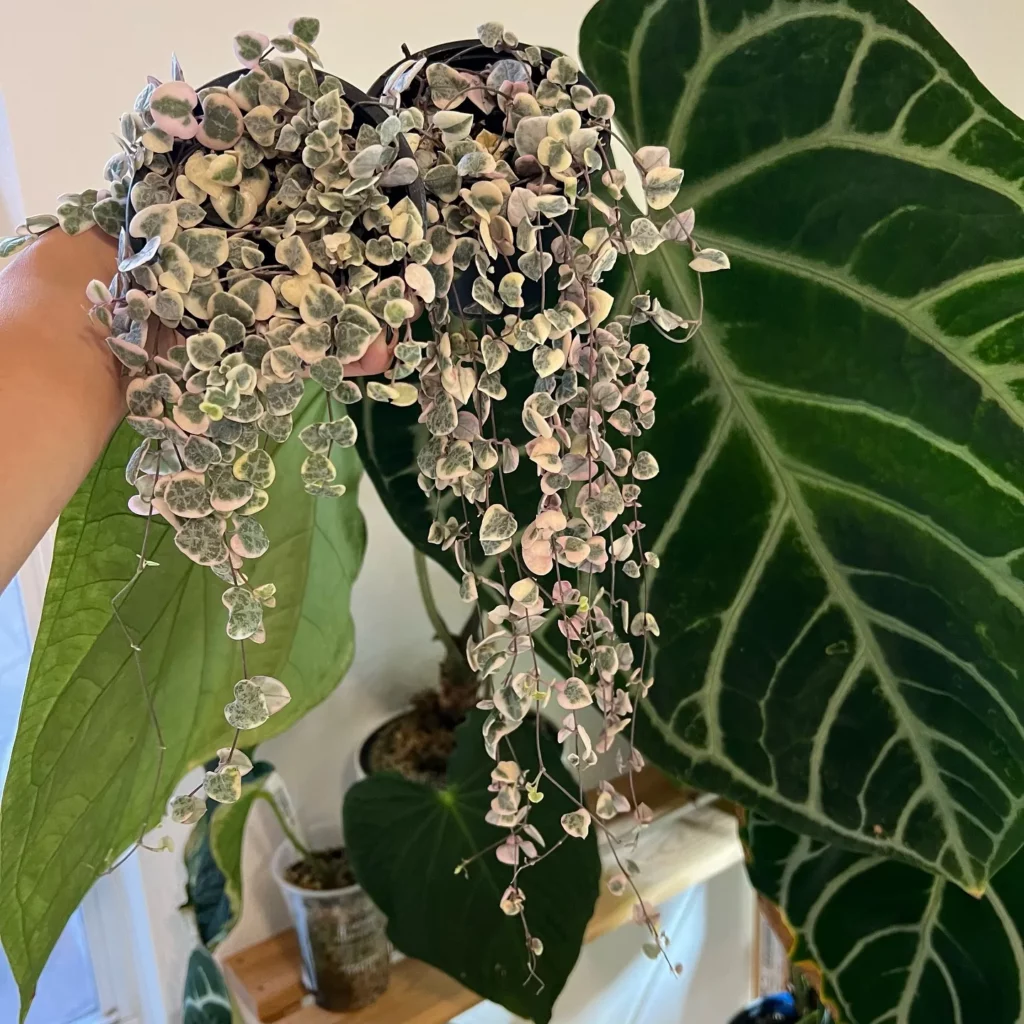
Proper watering is essential for the health and well-being of your String of Hearts plant. Finding the right balance and understanding its water requirements will help you ensure its vibrant growth and prevent common watering mistakes.
During the spring and summer months when the String of Hearts plant is actively growing, it’s important to provide regular watering while allowing the soil to completely dry out between waterings. This mimics the plant’s natural habitat, as it is native to arid regions of South Africa and Zimbabwe.
Avoid overwatering the String of Hearts plant, as it is drought-tolerant and can be damaged by excessive moisture. Overwatering can lead to root rot and other complications. Always ensure that the soil is well-draining and that excess water can freely flow out of the pot.
In the autumn and winter months, reduce the frequency of watering to prevent waterlogged soil. The plant’s growth slows down during this period, and it requires less water. Allow the soil to dry out more before giving it a thorough watering.
When it’s time to water your String of Hearts plant, thoroughly saturate the soil until it’s evenly moist. Allow any excess water to drain completely to avoid water accumulation. Remember, it’s better to underwater than overwater this resilient plant.
Here are some general guidelines to follow when watering your String of Hearts:
- Water the plant when the top inch of soil feels dry to the touch.
- Use room temperature water to avoid shocking the plant.
- Avoid misting the foliage directly as it can encourage fungal diseases.
- Consider using a moisture meter to accurately determine the moisture levels in the soil.
No products found.
Fertilizing the String of Hearts Plant

While caring for your String of Hearts plant, fertilization plays a crucial role in promoting healthy growth and vibrant foliage. Although this plant doesn’t require excessive fertilization, it is beneficial to fertilize pot-grown plants twice a year during the growing season.
When fertilizing your String of Hearts, choose a high-quality houseplant fertilizer suitable for succulents. It’s important to follow the instructions on the packaging to ensure the right dosage. Over-fertilization can be harmful to the plant, so stick to the recommended guidelines.
Fertilizing your String of Hearts provides essential nutrients that support its overall health and appearance. It enhances the plant’s ability to produce lush foliage and promotes vigorous growth.
When to Fertilize
Fertilize your String of Hearts plant in early spring when it begins its active growth phase. This initial fertilization helps to kick-start its growth and development for the upcoming season. Make sure to follow up with a second round of fertilization during mid-summer to maintain nutrient levels during the continued growth.
Choosing the Right Fertilizer
When selecting a fertilizer for your String of Hearts, opt for a balanced formula with equal amounts of nitrogen (N), phosphorus (P), and potassium (K). This balanced approach ensures that the plant receives all the essential nutrients it needs for healthy development.
Application Method
To ensure even distribution, dilute the fertilizer according to the package instructions. Apply the diluted solution to the soil around the base of the plant, avoiding direct contact with the leaves and stems. Evenly distribute the fertilizer in a circular motion, ensuring it spreads throughout the root zone.
Frequency and Quantity
String of Hearts plants have low to moderate fertilization requirements. Applying fertilizer twice a year during the growing season is generally sufficient. Follow the recommended dosage on the package, making sure not to exceed the specified quantity. Remember, excess fertilizer can lead to salt build-up and potentially harm the plant.
Additional Care Tips
Aside from regular fertilization, it’s essential to provide suitable growing conditions for your String of Hearts plant. Ensure it receives bright indirect light and is watered properly. Avoid overwatering, as this can lead to root rot. Find the right balance of light, water, and fertilization to keep your String of Hearts plant healthy and thriving.
Potting the String of Hearts Plant
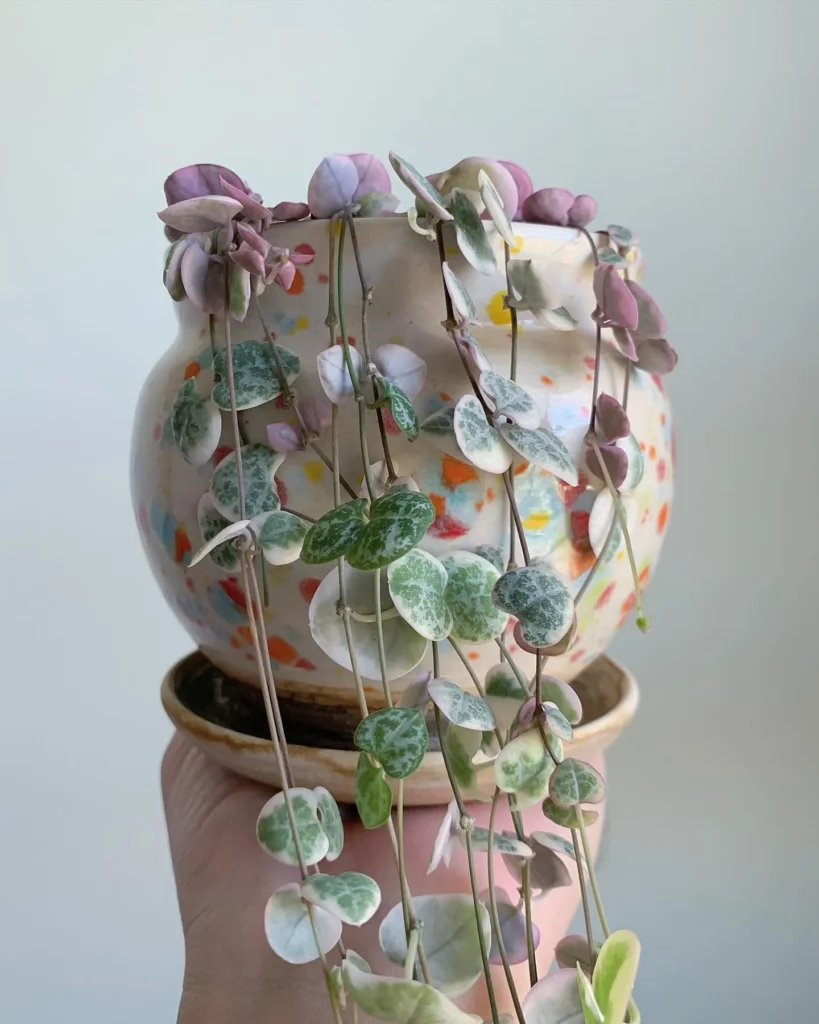
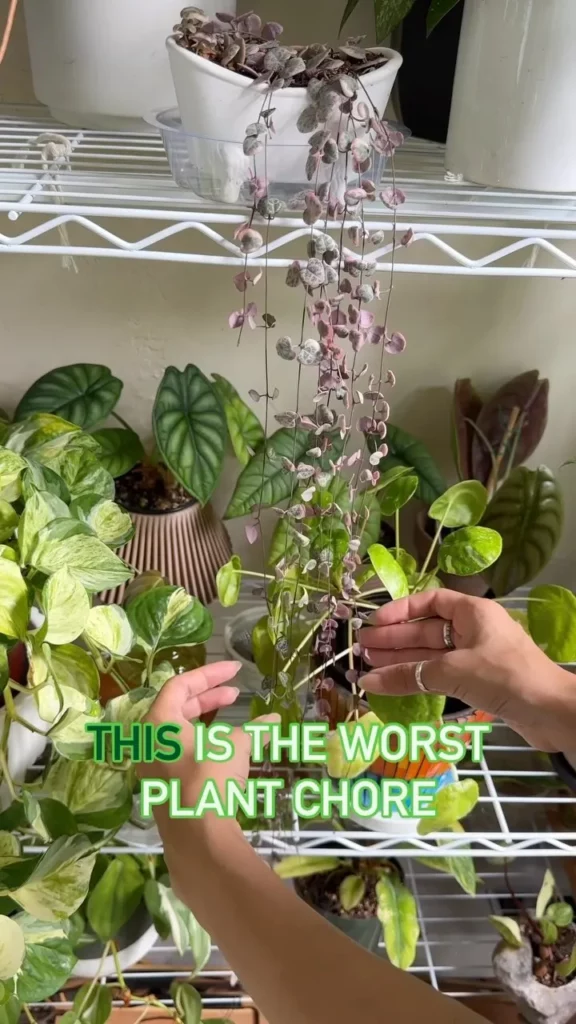

When your String of Hearts plant starts outgrowing its current pot, it’s time to consider repotting. Repotting allows the plant to have enough space for its roots to grow and ensures optimal health and growth. Here’s what you need to know about potting and repotting your String of Hearts plant:
- Choose the right container size: Select a slightly larger container than the current pot to accommodate the plant’s growth. The container should have drainage holes to prevent waterlogging and promote healthy root development.
- Use a well-draining compost mix: Opt for a free-draining compost mix to ensure adequate moisture retention without causing waterlogged soil. A suitable option is a peat-free cactus and succulent compost or a peat-free house plant compost mixed with perlite.
- Choose the ideal time for repotting: Late spring and summer, when the String of Hearts plant is in active growth, is the ideal time for repotting. This allows the plant to recover quickly from any root disturbance and adjust to its new container.
- Gently repot the plant: Carefully remove the plant from its current pot, being mindful not to damage too many roots. Place the plant in the new container, ensuring it sits at the same depth as before. Fill the remaining space with the compost mix, gently firming it around the roots.
- Water and monitor: After repotting, water the plant thoroughly to settle the soil and provide necessary hydration. Monitor the plant closely during the recovery phase and adjust watering accordingly to prevent overwatering.
No products found.
Propagation of the String of Hearts Plant
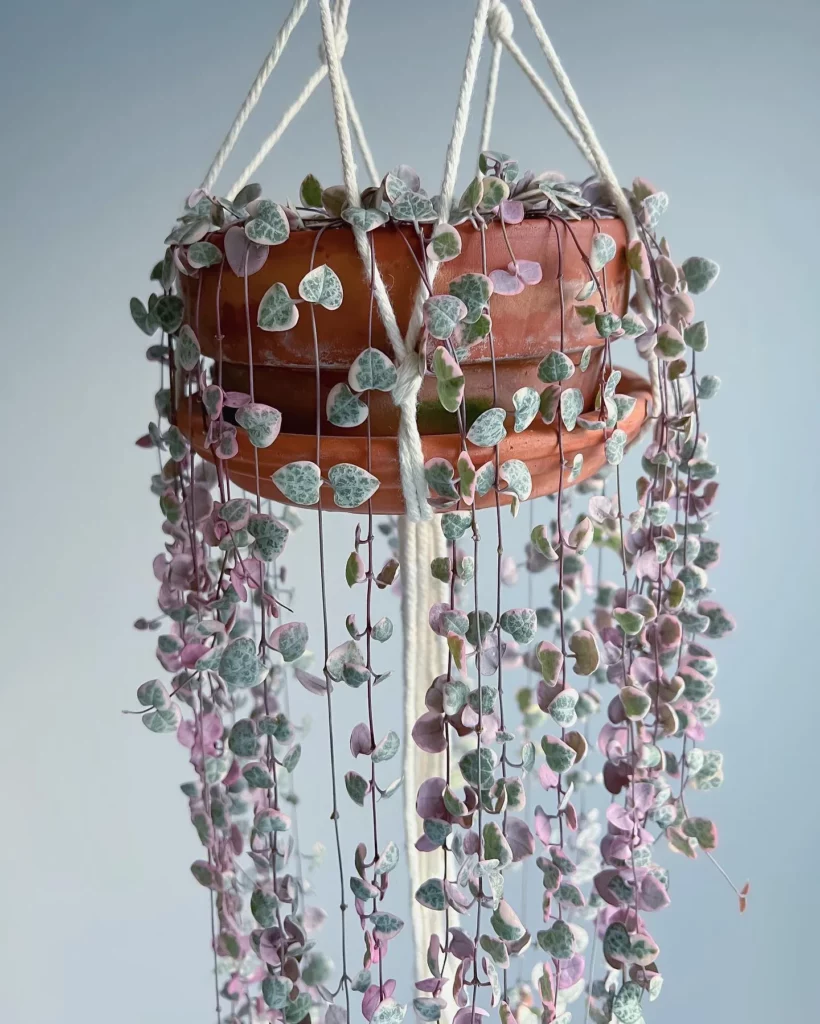
If you want to expand your String of Hearts plant collection or share the beauty of this charming plant with others, propagation is the way to go. Luckily, there are two effective methods for propagating the String of Hearts plant that you can try.
Propagation by Layering
The first and easier method for propagating the String of Hearts plant is through layering. This method takes advantage of the little bead-like aerial tubers that form on the vine after the plant flowers. These tubers have the ability to take root when they come into contact with soil, making propagation a breeze.
To propagate by layering, simply take a healthy-looking vine from your String of Hearts plant and drape it over a pot filled with damp compost. Make sure that at least one of the tubers makes contact with the compost. Next, keep the compost moist, but not waterlogged, and watch as roots start to develop from the tuber. Before you know it, you’ll have a new plant growing!
Stem Cuttings
The second method involves taking stem cuttings from your String of Hearts plant and encouraging them to develop roots before potting them into well-draining soil. This method may require a bit more patience compared to propagation by layering, but it is still an effective way to expand your plant collection.
To start, select a healthy vine and cut it into several sections, each with a few pairs of leaves. Place the cuttings in water and wait for the development of roots. Once the roots have grown to a sufficient length, transfer the cuttings into pots filled with well-draining soil. With proper care, these cuttings will grow into independent plants, ready to delight with their cascading foliage.
Growth and Development of the String of Hearts Plant



The String of Hearts plant is a fast-growing and resilient plant that can bring a lush green touch to your indoor space. With proper care, this plant has the potential to reach lengths of 2-3 meters, creating a beautiful cascading effect with its trailing vines and heart-shaped leaves. To ensure the healthy growth and development of your String of Hearts plant, it’s essential to provide the right conditions and care.
1. Regular Watering: Water your String of Hearts plant regularly, allowing the soil to dry out partially between waterings. Avoid overwatering, as this can lead to root rot. It’s always better to underwater this plant than to overwater it.
2. Adequate Light: Place your String of Hearts plant in a spot that receives bright, indirect light. While it can tolerate lower light conditions, it thrives best with ample light exposure. Avoid placing it in direct sunlight, as this can scorch the leaves.
3. Occasional Fertilization: Although the String of Hearts plant doesn’t require frequent fertilization, occasional feeding during the growing season can help promote healthy growth. Use a balanced houseplant fertilizer diluted to half strength and apply it every 2-4 weeks from spring to summer.
4. Adjusting Care: Monitor the growth of your String of Hearts plant and adjust the care accordingly. If you notice the plant becoming leggy or sparse, it may indicate a need for more light. On the other hand, if the leaves start to turn yellow or the growth slows down, it may be a sign of overwatering or inadequate light.
5. Pruning: Pruning your String of Hearts plant can help promote bushier growth and maintain an attractive shape. Trim back any leggy or excessive growth, and remove any yellow or diseased leaves to keep the plant healthy and vibrant.
6. Propagation: If you want to further develop your String of Hearts plant collection, you can propagate it through stem cuttings or by layering. These propagation methods allow you to create new plants from existing ones, expanding your plant’s growth and development.
Addressing Pests and Diseases in the String of Hearts Plant

While the String of Hearts plant is relatively hardy, it can still be susceptible to common houseplant pests such as mealybugs or spider mites. These pests can cause damage to the foliage and hinder the overall health of the plant. It’s important to be proactive in addressing these issues to ensure the continued vibrancy of your String of Hearts plant.
To minimize the risk of pest infestations, it’s essential to provide optimal growing conditions that reduce stress on the plant. Make sure to place your String of Hearts plant in a location with adequate airflow and avoid overwatering, as overly damp conditions can attract pests.
If you notice any signs of pest activity, such as mealybugs or spider mites, it’s crucial to take immediate action. One effective method of controlling pests is by using an organic pesticide specifically formulated for houseplants. Pyrol is a popular choice that can effectively eliminate pests while ensuring the safety of your plant.
Regularly inspect your String of Hearts plant for any signs of damage or disease, such as yellowing or wilting leaves, discolored spots, or unusual growth patterns. Early detection allows for prompt intervention, preventing any further damage. If you identify any issues, take appropriate measures to mitigate them, such as adjusting the lighting or humidity conditions, removing affected foliage, or treating with appropriate remedies.
Buying the String of Hearts Plant



If you’re looking to add a String of Hearts plant to your collection, there are several reputable online plant retailers where you can purchase them. Some options include Thompson & Morgan, Primrose, Crocus, and Bloombox. When buying a String of Hearts plant, it’s advisable to choose a larger plant for a more dramatic display. Always check for signs of damage or disease before purchasing to ensure you bring home a healthy plant.
Buying a String of Hearts plant is an exciting opportunity to enhance your indoor greenery. By exploring the offerings of online plant retailers, you can conveniently find the perfect addition to your plant collection. Thompson & Morgan, Primrose, Crocus, and Bloombox are popular choices for purchasing String of Hearts plants.
When making your purchase, consider opting for a larger plant. These plants are often more established and will create an instant impact in your space. Choose a healthy plant by carefully inspecting it for any signs of damage or diseases. Look for vibrant foliage, undamaged vines, and well-developed roots.
By purchasing a String of Hearts plant from reputable online plant retailers, you can buy with confidence, knowing that you’re getting a quality plant. With the right care and attention, your new String of Hearts plant will thrive and become a beautiful centerpiece in your home.
Conclusion
With its unique appearance and easy care requirements, the String of Hearts plant has become a favorite among plant enthusiasts. By following the simple tips outlined in this care guide, you can ensure that your String of Hearts plant thrives and displays vibrant growth.
Remember to provide the String of Hearts plant with appropriate lighting, placing it in a spot that receives bright indirect light. Water sparingly but consistently, allowing the soil to dry out between waterings to prevent overwatering and root rot.
When fertilizing, use a house plant fertilizer twice a year during the growing season, following the package instructions to avoid over-fertilization. Monitor the plant for common pests and diseases, such as mealybugs or spider mites, and take immediate action to address any infestations or issues.
With proper care, your String of Hearts plant will continue to bring joy and beauty to your home or office space, creating cascades of heart-shaped foliage that are sure to catch attention. Enjoy the experience of nurturing and watching your String of Hearts thrive!
FAQ
How often should I water my String of Hearts plant?
Water your String of Hearts plant regularly during the spring and summer, allowing the soil to completely dry out between waterings. In the autumn and winter months, reduce watering and make sure the plant is never left sitting in waterlogged soil.
How much light does a String of Hearts plant need?
The String of Hearts plant thrives in bright indirect light. It should be placed in a spot that receives ample light but is protected from direct sunlight, especially during the heat of the day.
How often should I fertilize my String of Hearts plant?
It is recommended to fertilize your pot-grown String of Hearts plant twice a year during the growing season. Use a house plant fertilizer and follow the instructions on the packaging for the appropriate dosage.
When should I repot my String of Hearts plant?
Repot your String of Hearts plant when it starts outgrowing its current pot. Late spring and summer, when the plant is in active growth, is the ideal time for repotting. Choose a slightly larger container and use a free-draining compost mix.
How can I propagate my String of Hearts plant?
There are two effective methods for propagating the String of Hearts plant. One method is propagation by layering, where you allow aerial tubers to develop roots by making contact with damp compost. The second method involves taking stem cuttings, rooting them in water, and then potting them into well-draining soil.
How long can the vines of a String of Hearts plant grow?
With proper care, the vines of a String of Hearts plant can reach lengths of 2-3 meters. The plant continues to develop and produce new leaves, adding to the cascading effect.
How do I address pests and diseases in my String of Hearts plant?
If an infestation occurs, treat your String of Hearts plant with an organic pesticide, such as Pyrol. Regularly inspect the plant for signs of damage or disease and take proactive measures to address any issues.
Where can I buy a String of Hearts plant?
You can purchase a String of Hearts plant from reputable online plant retailers such as Thompson & Morgan, Primrose, Crocus, and Bloombox. When buying, check for signs of damage or disease to ensure a healthy plant.




